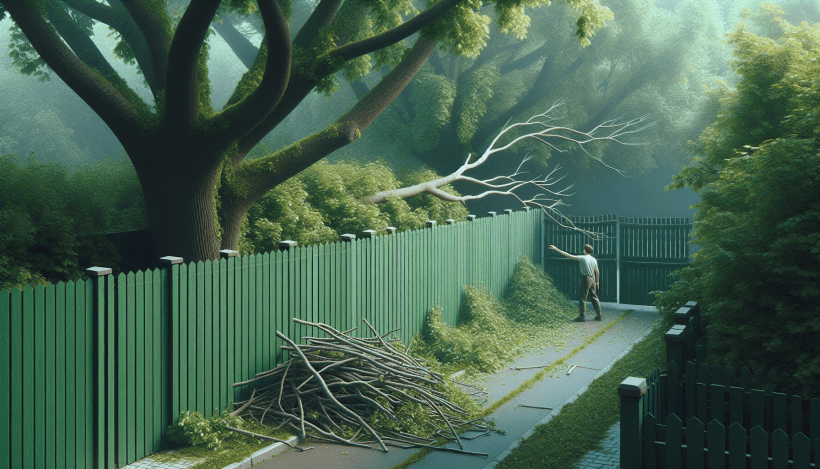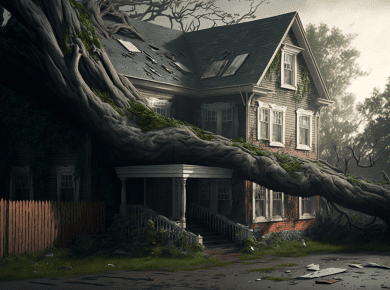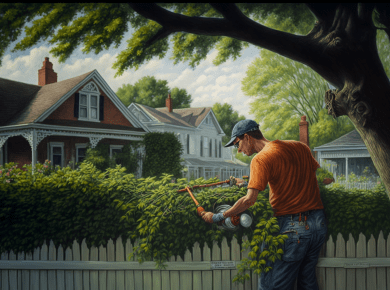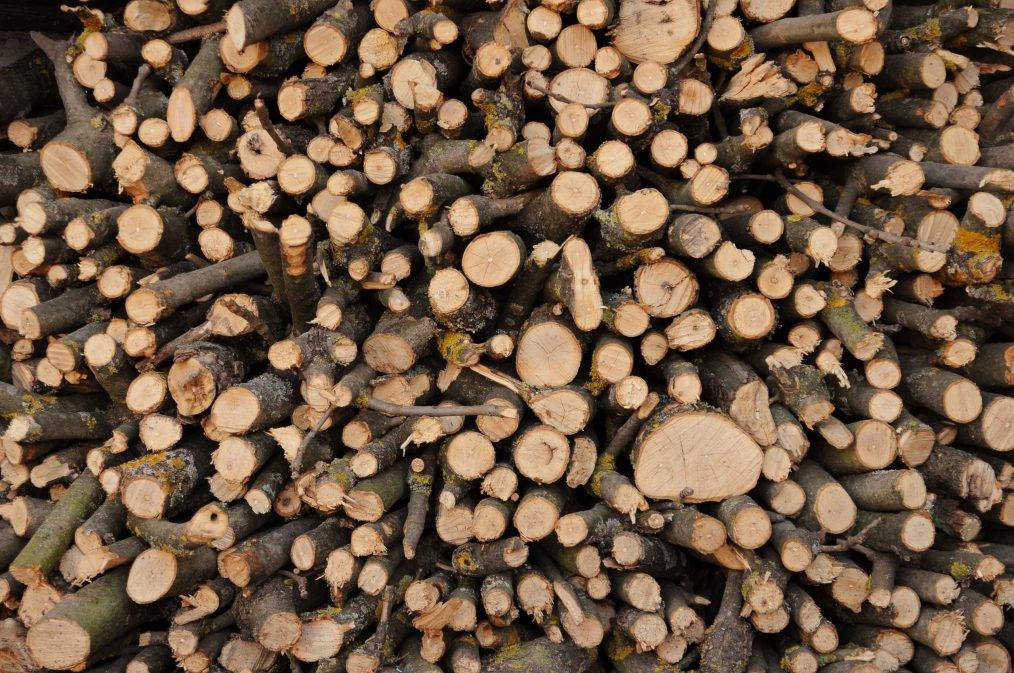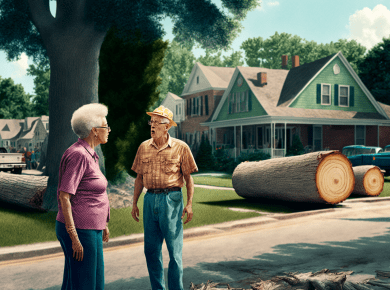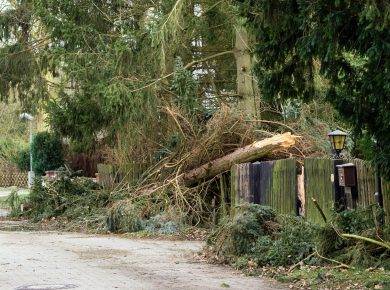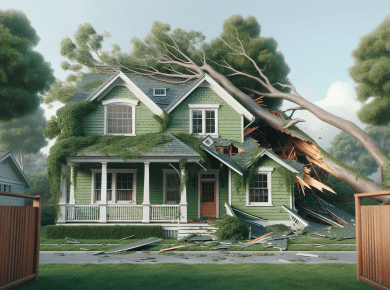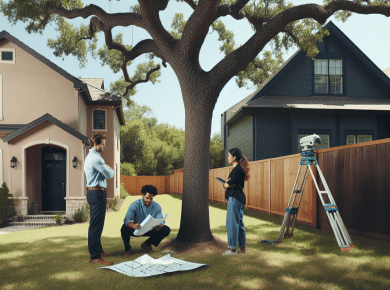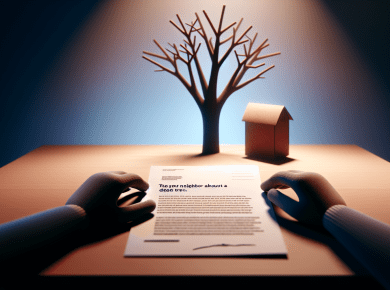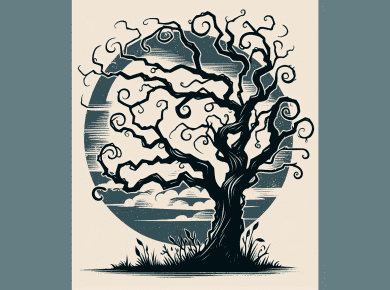Understanding Tree Hazards and Risks
Tree hazards can pose significant risks to properties and safety. Understanding liability, recognizing unsafe signs, and emphasizing the importance of professional inspections are crucial steps neighbors can take to manage tree-related issues effectively.
Tree Damage Liability
When tree branches fall and cause damage, determining liability can be complex. Generally, tree owners are responsible for maintaining their trees and removing any hazards. However, if a tree in a neighbor’s yard poses a danger and goes unaddressed, the homeowner may face potential liability. It’s essential for property owners to understand their responsibilities regarding trees that could encroach upon neighboring properties. For detailed guidance on liability concerns, refer to our article on who is responsible for cutting overhanging tree branches.
Recognizing Unsafe Tree Signs
Identifying the signs of an unsafe tree is essential for preventing damage and ensuring safety. Various indicators may signal that a tree requires immediate attention:
| Unsafe Sign | Description |
|---|---|
| Dead Tree Limbs | Dead limbs can decay and weaken, still attached to the tree, posing a risk of falling. (Joshua Tree Experts) |
| Leaning Trees | A tree that has suddenly begun leaning may be indicative of root damage or instability. |
| Included Bark | This occurs when branches grow too closely together, risking breakage under stress. (Arbor Works) |
| Damaged Roots | Roots damaged by construction or natural events may compromise the tree’s stability. |
| Stress Fractures | Cracks in the trunk or major branches could signal internal damage requiring attention. |
Understanding these indicators helps property owners take proactive steps in managing tree health.
Importance of Professional Inspections
Professional tree inspections are vital for assessing tree stability and safety. A certified arborist can provide an expert evaluation to determine if a tree poses a risk. They can suggest solutions such as pruning, cabling, bracing, or, if necessary, removal. Obtaining a professional opinion can mitigate legal and safety concerns related to tree damage. For more resources on managing tree risks, visit our page on what to do if a neighbor has a dangerous tree: what can i do if my neighbor has a dangerous tree.
Steps After Discovering Tree Risks
After discovering potential risks associated with trees on or near your property, it is essential to take appropriate steps to address the situation. This section outlines how to mitigate hazards, consider legal implications, and effectively communicate with neighbors.
Mitigating Tree Hazards
Mitigating tree hazards is crucial to prevent damage to property and ensure safety. Signs that a tree poses a risk include dead limbs, hanging branches, leaning trunks, and visible cracks or fractures (Arbor Works). Here are some actions homeowners can take:
| Action | Description |
|---|---|
| Remove Dead Branches | Promptly cut dead limbs to prevent accidents and further damage during storms. |
| Prune Overlapping Branches | Trimming branches that rub against each other reduces friction and potential breakage. |
| Evaluate Tree Structure | Regular assessments can help identify trees with poor structure, which are at higher risk of breaking (Joshua Tree Experts). |
| Contact Professionals | Getting a professional tree inspection is a key step to determine safety. Professionals may suggest cabling, bracing, or tree removal if necessary. |
Legal Implications of Tree Damage
Understanding the legal implications of tree damage is vital for property owners. If a neighbor’s tree causes damage to property, the affected homeowner may wonder, “can I throw my neighbor’s tree branches back in their yard?” While property owners may feel justified in returning branches, the legality can be complex. Here are some important points to consider:
- Neighbors have the right to maintain their trees; however, causing damage can lead to potential liability claims.
- If a neighbor’s tree is found to be dangerous or unhealthy and causes harm, the neighbor may be liable for damages (can you sue someone for cutting down trees on your property).
- It’s advisable to keep records of any damages, communication with neighbors, and actions taken regarding the tree for reference in case of disputes.
Communicating with Neighbors
Effective communication with neighbors is essential for resolving tree-related disputes amicably. When contacting a neighbor about tree issues, consider sending a formal letter. Here are some communication tips:
- Be Polite and Courteous: Start the conversation lightly, as it helps maintain a good relationship.
- State Observations Clearly: Provide specific details regarding the tree’s condition and how it poses risks.
- Include Suggestions: Offer solutions, such as having a professional inspect the tree together.
- Use Template Letters: Utilize and customize template letters available through internal resources to formally document your communication. For instance, you can refer to a tree trimming request letter to neighbor or a letter to neighbor about tree.
Taking these steps ensures that homeowners address potential hazards effectively while maintaining neighborly relations and understanding their legal rights.
Homeowners Associations and Tree Disputes
Homeowners Associations (HOAs) often play a significant role in managing neighborhood disputes regarding trees and property lines. Understanding the regulations set forth by these organizations can aid in resolving conflicts amicably.
HOA Regulations on Trees
HOAs typically have specific guidelines regarding tree care, maintenance, and removal. These regulations aim to maintain aesthetic standards and ensure the safety of the community. Homeowners should familiarize themselves with their HOA’s bylaws to understand what is permissible regarding tree maintenance. This may include:
- Tree trimming and removal guidelines
- Restrictions on types of trees planted
- Responsibilities for maintaining common areas
Property owners should refer to their HOA documents to ensure compliance and prevent potential disputes.
Handling HOA Violations
If a neighbor has violated HOA regulations regarding trees, several steps can be taken:
- Review the HOA Rules: Property owners should start by reviewing the specific rules related to trees in their HOA’s documentation.
- Document Violations: Collect evidence of the violation, such as photographs or videos, to support any claims made to the HOA.
- Communicate with the Neighbor: Before escalating the matter, it may be beneficial to approach the neighbor directly to discuss the issue. This can sometimes lead to a resolution without further action.
- Report to the HOA: If the situation remains unresolved, the homeowner can report the violation to the HOA, which will take action based on its enforcement policy.
Understanding the HOA approach to tree care can empower homeowners in resolving disputes effectively.
Options for Dispute Resolution
When facing tree disputes, homeowners have several options for resolution, including:
| Options | Description |
|---|---|
| Direct Negotiation | Open communication with the neighbor to discuss concerns and seek a mutual resolution. |
| Mediation | Involving a neutral third party to help facilitate a resolution between conflicting neighbors. |
| HOA Intervention | Seeking assistance from the HOA to enforce regulations or mediate disputes. |
| Legal Action | Filing a lawsuit if the issue escalates and significantly impacts property rights. Homeowners should consult a lawyer for guidance on this option, particularly if they are wondering, can I sue someone for cutting down trees on your property. |
Navigating tree disputes within HOA frameworks requires awareness of regulations, effective communication, and understanding available resolution methods. If challenges persist, residents can seek legal advice to fully understand their rights and options in these situations. For further assistance, property owners may find value in referencing a letter to neighbor about tree to open dialogues about mutual concerns.
Neighborly Tree Concerns in Ohio
Understanding tree trimming laws and liability issues is crucial for neighbors in Ohio to avoid disputes over property rights and tree maintenance.
Ohio Tree Trimming Laws
In Ohio, property owners have the right to trim overhanging tree limbs that extend over their property. However, this right comes with limitations. It is essential to avoid actions that could infringe upon a neighbor’s rights, such as entering their property without permission or leaving debris on their side. Violating these guidelines may result in penalties of up to $250 or 30 days in jail, alongside potential damages up to three times the worth of the affected tree (Ohio Farm Bureau).
| Action | Legal Status |
|---|---|
| Trimming overhanging limbs | Allowed with restrictions |
| Trespassing on neighbor’s property | Prohibited |
| Placing trimmed debris on neighbor’s property | Prohibited |
| Trimming tree parts on neighbor’s property | Prohibited |
Resolving Tree Disputes with Neighbors
Open communication is vital when dealing with tree disputes. It is advisable to seek a neighbor’s permission before removing any tree that straddles the property line. Establishing a dialogue regarding the removals, covering costs, entering properties for removal, and debris disposal can prevent conflicts and result in a better neighborly experience (Ohio Farm Bureau). For formal communication, consider using templates such as a tree trimming request letter to neighbor or a sample encroachment letter.
Liability for Tree Damage in Ohio
In Ohio, landowners typically are not held liable for damage from a tree falling from their property unless there were prior indicators that it was at risk of falling. If a tree is found to be damaged, diseased, or dead, the owner may be responsible for any damage caused by its fall (Ohio Farm Bureau). Neighbors should be aware of these regulations and how they intersect with personal responsibility. For further clarification on property disputes and responsibilities, refer to the article on who is responsible for cutting overhanging tree branches.
Understanding these aspects can help neighbors navigate tree concerns effectively and maintain positive relationships within their communities.
Utility Companies and Tree Trimming Rights
Understanding the rights of utility companies regarding tree trimming is essential for homeowners and neighbors concerned about property damage and maintenance. Utility companies often have authority to manage vegetation around their infrastructure, which can lead to disputes between property owners and utility firms.
Utility Rights vs. Property Owners
Utility companies generally hold the right to trim trees on private properties when necessary to maintain utility infrastructure. This authority is often established through right of way or easement agreements. In most cases, landowners are unable to prevent utility companies from exercising this right, even if the trees were not previously trimmed. The primary goal of these actions is to ensure safety and reliability of services provided to the community (Ohio Farm Bureau).
Understanding Utility Easements
A utility easement is a legal right allowing utility companies access to private land for specific purposes, such as installing and maintaining electrical, water, sewer, and telecommunication lines. These easements can influence property lines and rights of way, providing utility companies with the authority to trim or remove vegetation obstructing access to their infrastructure.
| Aspect | Description |
|---|---|
| Easement Type | Grants utility companies specific rights |
| Access | Allows entry onto private property for maintenance |
| Tree Management | Provides authority to trim or remove trees as necessary |
Homeowners should be aware of any easements affecting their property, as these can determine what actions can be taken regarding landscaping.
Utility Intervention in Tree Management
When utility companies intervene in tree management, they typically assess the health and position of the trees in relation to utility lines. Their primary concern is to prevent outages and safety hazards caused by overhanging branches or tree falls.
Neighbors facing disputes regarding tree management by utilities can find it helpful to:
- Review any existing easement agreements associated with their property.
- Communicate with utility representatives to understand the scope of their rights and responsibilities.
- Consider documenting any tree issues, such as potential hazards or damage caused by utility trimming.
For assistance regarding tree-related issues or to draft communication with neighbors or utility companies, tenants can refer to resources on writing a letter to neighbor about tree, or tree trimming request letter to neighbor.
